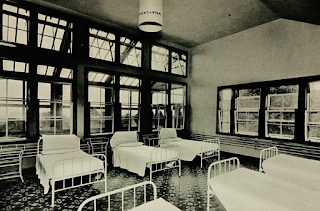The Trans-Alleghany Lunatic Asylum (TALA) began its construction in 1858 with a final completion date of 1881. TALA, an institution for the mentally unstable, was opened by the movement following Dorothea Dix's observations of harsh and cruel imprisonment of the mentally ill in jails. Dix, working closely with Thomas Kirkbride, began advocating and promoting the need for improved treatment for the mentally ill. TALA, the second largest hand-cut stone masonry building in the world and largest in North America, embodied the Kirkbride layout; expanding nearly a quarter of a mile in length with multiple wings providing optimum sunlight and fresh air to patients who resided at TALA.
TALA opened for its doors to the first 250 patients in 1864. These patients were made up of individuals who were found to have epilepsy, alcohol and drug additions, and "non-educated mental defectives."
TALA, at its final construction, was four stories tall and included space for both patients and staff. The patients had large, elegant sitting rooms, kitchen, living room, barber shop, beauty parlor, dentist office, medical offices, chapel, athletic fields and indoor courts, specialized wings (geriatric wards), and art rooms. The staff had lounge/break rooms, apartments, medical offices, operating rooms, morgues, and so on.
In 1861, with only one wing constructed, the town of Weston, was overrun by the Civil War's Colonel Erastus Bernard Tyler of the Seventh Ohio Infantry and his platoon. Being familiar with Weston, Colonel Tyler was aware of TALA's construction and where the funds were being kept; the Weston Branch of the Exchange Bank of Virginia. Stealing $27,000.00 of the $30,000.00 (equally today as over a half million dollars) in gold the Virginia State Government had, Colonel Tyler and his platoon set up shop at TALA and nicknamed it as "Camp Tyler." The money was taken to Wheeling, Virginia and ended up funding the division of states creating the state of West Virginia.
Between 1862 and 1864, the Confederates raided TALA, stealing nearly $5,300.00 in cash from the same bank, as well as TALA's food and clothing. At the end of the war, despite expectations, TALA rebounded and became an economic resource to Weston. TALA, now 1863, was being referred to as the West Virginia Hospital for the Insane.
In the early 1900's, TALA began evolving in its care and treatment towards the patients'. Patients, due to the overcrowding, were forced to sleep on the floor or take shifts sleeping in the beds. Three to five patients were placed in small rooms that were designed for one patient. This resulted in a widespread neglect including patient deaths due to starvation, unruly patients being forced to sleep in cages, and patients sleeping in the hallways.
TALA experienced another name change in the early 1900's, Weston State Hospital. TALA remained named as the Weston State Hospital until its closure date in May of 1994. Though several name changes occurred, historians continue to refer to the Weston State Hospital as TALA.
Through the remaining century that TALA's doors were open, the treatment to patients continued to change. During the 1950's TALA became home for the West Virginia Lobotomy Project. This Project was launched with the hopes of reducing the overcrowding as the former 250 bed facility had hit its peak capacity of over 2,400 patients, more than six times the intended amount.

During the same time, a local paper, the Charleston Gazette, began interviewing staff and patients at TALA in hopes of exposing the maltreatment with a subsequent closure of the facility. Aside from the overcrowding and starvation that was occurring, TALA patients were living with minimal furniture, no heat, and extremely poor sanitation. Paint could be seen peeling off the walls, puddles of water formed on various spots on the floors from the leaking cleanings, and grime covered the windows to the point of darkness. Though the Charleston Gazette brought light to the neglectful conditions within TALA, the institution remained open for nearly another 50 years.
The remaining years that TALA was open, the staff expanded once more, only this time, it was the graveyard expanding; a vast 666 acres, to help resolve the raising death rates. To date, ledger has not been found stating the patients names, alleged illness(s), or release/death dates.
In 2007, after over a decade of being abandoned, TALA was auctioned off and purchased by a local resident, Joe Jordan. Jordan and his family began renovating TALA, primarily in the main building titled Kirkbride. TALA is now opened Monday through Friday from 9:00 am to 5:00 pm for guided historical tours, and paranormal tours. TALA also provides a plethora of community events such as local high school sporting events, cook-outs for local businesses and much more. Lastly, TALA, the infamous institution, has been featured on multiple documentaries and paranormal activity-based shows.

























